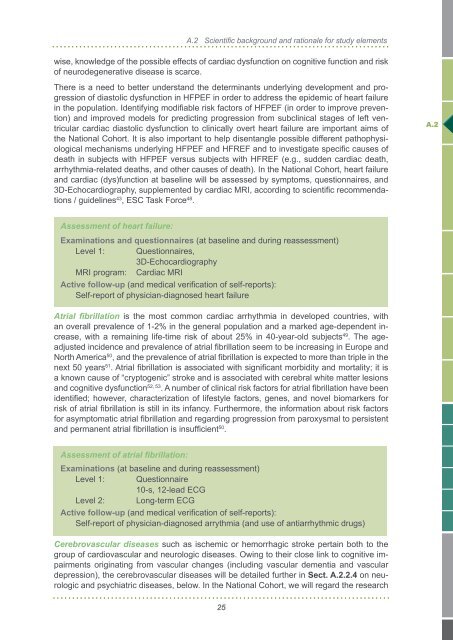Scientific Concept of the National Cohort (status ... - Nationale Kohorte
Scientific Concept of the National Cohort (status ... - Nationale Kohorte
Scientific Concept of the National Cohort (status ... - Nationale Kohorte
You also want an ePaper? Increase the reach of your titles
YUMPU automatically turns print PDFs into web optimized ePapers that Google loves.
A.2 <strong>Scientific</strong> background and rationale for study elements<br />
wise, knowledge <strong>of</strong> <strong>the</strong> possible effects <strong>of</strong> cardiac dysfunction on cognitive function and risk<br />
<strong>of</strong> neurodegenerative disease is scarce.<br />
There is a need to better understand <strong>the</strong> determinants underlying development and progression<br />
<strong>of</strong> diastolic dysfunction in HFPEF in order to address <strong>the</strong> epidemic <strong>of</strong> heart failure<br />
in <strong>the</strong> population. Identifying modifiable risk factors <strong>of</strong> HFPEF (in order to improve prevention)<br />
and improved models for predicting progression from subclinical stages <strong>of</strong> left ventricular<br />
cardiac diastolic dysfunction to clinically overt heart failure are important aims <strong>of</strong><br />
<strong>the</strong> <strong>National</strong> <strong>Cohort</strong>. It is also important to help disentangle possible different pathophysiological<br />
mechanisms underlying HFPEF and HFREF and to investigate specific causes <strong>of</strong><br />
death in subjects with HFPEF versus subjects with HFREF (e.g., sudden cardiac death,<br />
arrhythmia-related deaths, and o<strong>the</strong>r causes <strong>of</strong> death). In <strong>the</strong> <strong>National</strong> <strong>Cohort</strong>, heart failure<br />
and cardiac (dys)function at baseline will be assessed by symptoms, questionnaires, and<br />
3D-Echocardiography, supplemented by cardiac MRI, according to scientific recommendations<br />
/ guidelines 43 , ESC Task Force 48 .<br />
Assessment <strong>of</strong> heart failure:<br />
Examinations and questionnaires (at baseline and during reassessment)<br />
Level 1: Questionnaires,<br />
3D-Echocardiography<br />
MRI program: Cardiac MRI<br />
Active follow-up (and medical verification <strong>of</strong> self-reports):<br />
Self-report <strong>of</strong> physician-diagnosed heart failure<br />
Atrial fibrillation is <strong>the</strong> most common cardiac arrhythmia in developed countries, with<br />
an overall prevalence <strong>of</strong> 1-2% in <strong>the</strong> general population and a marked age-dependent increase,<br />
with a remaining life-time risk <strong>of</strong> about 25% in 40-year-old subjects 49 . The ageadjusted<br />
incidence and prevalence <strong>of</strong> atrial fibrillation seem to be increasing in Europe and<br />
North America 50 , and <strong>the</strong> prevalence <strong>of</strong> atrial fibrillation is expected to more than triple in <strong>the</strong><br />
next 50 years 51 . Atrial fibrillation is associated with significant morbidity and mortality; it is<br />
a known cause <strong>of</strong> “cryptogenic” stroke and is associated with cerebral white matter lesions<br />
and cognitive dysfunction 52, 53 . A number <strong>of</strong> clinical risk factors for atrial fibrillation have been<br />
identified; however, characterization <strong>of</strong> lifestyle factors, genes, and novel biomarkers for<br />
risk <strong>of</strong> atrial fibrillation is still in its infancy. Fur<strong>the</strong>rmore, <strong>the</strong> information about risk factors<br />
for asymptomatic atrial fibrillation and regarding progression from paroxysmal to persistent<br />
and permanent atrial fibrillation is insufficient 50 .<br />
Assessment <strong>of</strong> atrial fibrillation:<br />
Examinations (at baseline and during reassessment)<br />
Level 1: Questionnaire<br />
10-s, 12-lead ECG<br />
Level 2: Long-term ECG<br />
Active follow-up (and medical verification <strong>of</strong> self-reports):<br />
Self-report <strong>of</strong> physician-diagnosed arrythmia (and use <strong>of</strong> antiarrhythmic drugs)<br />
Cerebrovascular diseases such as ischemic or hemorrhagic stroke pertain both to <strong>the</strong><br />
group <strong>of</strong> cardiovascular and neurologic diseases. Owing to <strong>the</strong>ir close link to cognitive impairments<br />
originating from vascular changes (including vascular dementia and vascular<br />
depression), <strong>the</strong> cerebrovascular diseases will be detailed fur<strong>the</strong>r in Sect. A.2.2.4 on neurologic<br />
and psychiatric diseases, below. In <strong>the</strong> <strong>National</strong> <strong>Cohort</strong>, we will regard <strong>the</strong> research<br />
25<br />
A.2



